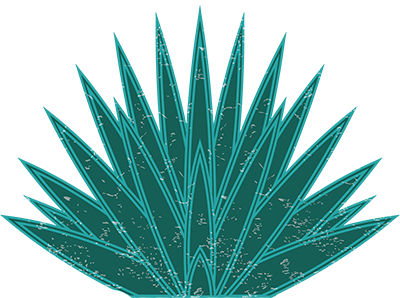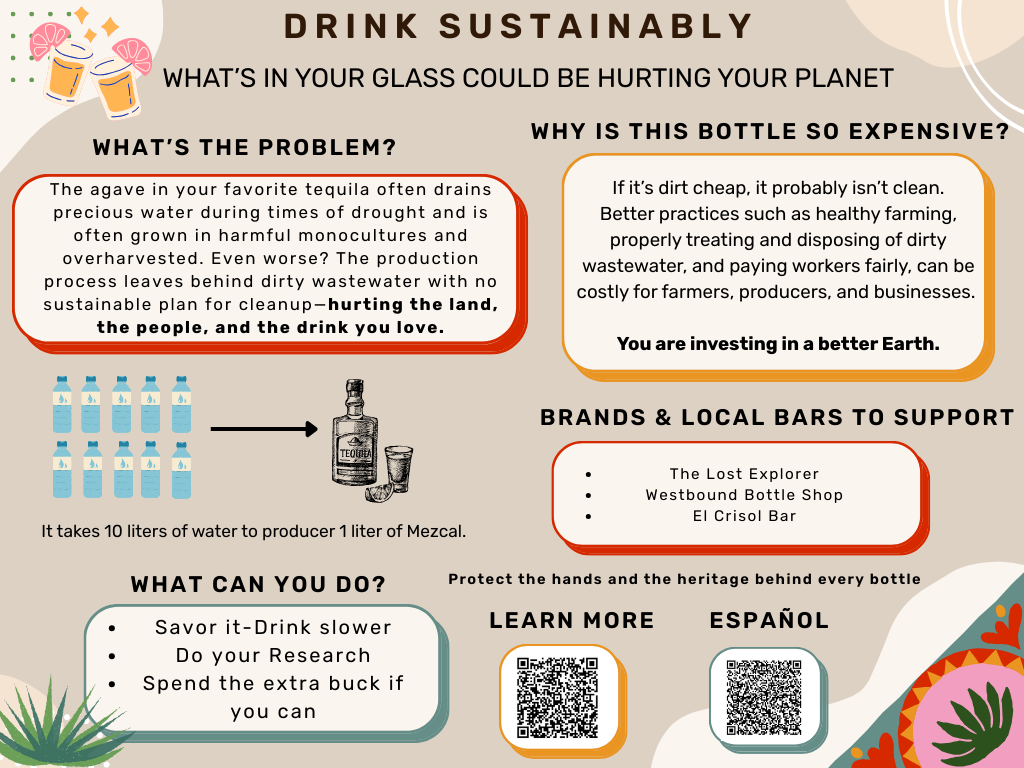A Guide to More Sustainable Mezcal
by University of Arizona W.A. Franke Honors Students: Abby Witt, Alivia Bell, Neha Nerkar & Jacob Bagley
From Field to Bottle
Agave has been an important plant for Indigenous communities for thousands of years. People used it to make clothing, rope, and tools, and its use goes back more than 12,000 years. When Spanish settlers arrived, they started distilling agave to create mezcal and tequila. Today, agave is also used as a natural sweetener in foods and drinks like smoothies and coffee.
Growing Agave: Agave grows best in sunny, dry areas with well-drained, sandy, or volcanic soil. Farmers look for land that has full sunlight, a slightly acidic to neutral pH, and an elevation between 1,200 and 2,000 meters. Once the land is cleared of rocks and weeds, they may shape rows or mounds to help with drainage and sometimes add organic matter to improve soil quality.
Planting and Propagation: Agave is usually planted using “pups,” which are small offshoots that grow from the base of mature plants. Farmers remove these pups by hand, let them dry for a few days to prevent rot, and then plant them in rows spaced about one to two meters apart. This method creates consistent plants but also reduces genetic diversity, which can make crops more vulnerable to pests.
Caring for the Crop: Agave takes between six and ten years to mature. During that time, jimadores (farmers) care for the plants by removing weeds, controlling pests like the agave weevil, pruning damaged leaves, and improving soil health with compost or minerals. Before harvest, farmers cut the tall flowering stalk, called the quiote, to keep the plant’s sugars concentrated in the heart, or piña. This step is important for producing high-quality mezcal.
Harvest and Replanting: When the agave is mature, the jimadores trim away the leaves and harvest the piña. The field is then replanted with new pups or left to rest so the soil can recover.
Protect the Pollinators: Bats are one of the most important pollinators in the Sonoran Desert. They help pollinate plants, spread seeds, and keep insect populations under control. Many bat species depend on agave for food, feeding on its nectar and pollen. In return, they help pollinate the plant. Protecting bats helps protect agave and the health of desert ecosystems.
How Mezcal Is Made
Harvest – Farmers cut off the agave leaves to reveal the piña, or heart of the plant.
Roasting – The piñas are roasted in stone-lined pits, which gives mezcal its smoky flavor.
Crushing – The roasted hearts are crushed with a stone wheel or by hand to release their sweet juices.
Fermentation – The juice is mixed with water in open vats, where natural yeasts turn the sugars into alcohol over 8 to 20 days.
Distillation – The fermented mixture is distilled, usually twice, in copper, clay, or wooden stills to refine the flavor.
Aging (Optional) – Some mezcals are aged in barrels to develop a deeper and more complex taste.
Choosing Sustainable Mezcal
Buying mezcal is not just about taste. It is also about making choices that support people, land, and biodiversity. Here are four easy ways to make sure the mezcal you buy is sustainable:
Look for “100% Agave”
This means the mezcal is made entirely from agave, without added sugars. It usually comes from smaller, more sustainable producers.Check for Traditional Methods
Labels that say “Hecho en México,” “small-batch,” “tahona-crushed,” or “brick-oven roasted” point to more traditional and lower-impact production processes.Research the Brand
Check the company’s website for information on sustainability, biodiversity, or fair labor practices. If they never mention these topics, they probably are not practicing them.Be Ready to Pay a Little More
Sustainable mezcal usually costs more because it supports fair wages, responsible water use, and long-term agave health.


